Ver ítem
- xmlui.general.dspace_homeCentros e Institutos de InvestigaciónCICVyA. Centro de Investigación en Ciencias Veterinarias y AgronómicasInstituto de BiotecnologíaArtículos científicosxmlui.ArtifactBrowser.ItemViewer.trail
- Inicio
- Centros e Institutos de Investigación
- CICVyA. Centro de Investigación en Ciencias Veterinarias y Agronómicas
- Instituto de Biotecnología
- Artículos científicos
- Ver ítem
Early genetic consequences of defaunation in a large-seeded vertebrate-dispersed palm (Syagrus romanzoffiana)
Resumen
Plant populations are seriously threatened by anthropogenic habitat disturbance. In particular, defaunation may disrupt plantdisperser mutualisms, thus reducing levels of seed-mediated gene flow and genetic variation in animal-dispersed plants. This may ultimately limit their adaptive potential and ability to cope with environmental change. Tropical forest remnants are typically deprived of medium to large vertebrates upon which many large-seeded plants
[ver mas...]
Plant populations are seriously threatened by anthropogenic habitat disturbance. In particular, defaunation may disrupt plantdisperser mutualisms, thus reducing levels of seed-mediated gene flow and genetic variation in animal-dispersed plants. This may ultimately limit their adaptive potential and ability to cope with environmental change. Tropical forest remnants are typically deprived of medium to large vertebrates upon which many large-seeded plants rely for accomplishing effective seed dispersal.
Our main goal was to examine the potential early genetic consequences of the loss of large vertebrates for large-seeded vertebrate-dispersed plants. We compared the genetic variation in early-stage individuals of the large-seeded palm Syagrus romanzoffiana between continuous protected forest and nearby partially defaunated fragments in the Atlantic Forest of South America. Using nine microsatellites, we found lower allelic richness and stronger fine-scale spatial genetic structure in the disturbed area. In addition, the percentage of dispersed recruits around conspecific adults was lower, although not significantly, in the disturbed area (median values: 0.0 vs 14.4%). On the other hand, no evidence of increased inbreeding or reduced pollenmediated gene flow (selfing rate and diversity of pollen donors) was found in the disturbed area. Our findings are strongly suggestive of some early genetic consequences resulting from the limitation in contemporary gene flow via seeds, but not pollen, in defaunated areas. Plant-disperser mutualisms involving medium–large frugivores, which are seriously threatened in tropical systems, should therefore be protected to warrant the maintenance of seed-mediated gene flow and genetic diversity in large-seeded plants.
[Cerrar]

Autor
Giombini, Mariano Ignacio;
Bravo, Susana Patricia;
Sica, Yanina Vanesa;
Tosto, Daniela Sandra;
Fuente
Heredity 118 (6) : 568-577. (2017)
Fecha
2017
ISSN
0018-067X (Print)
1365-2540 (Online)
1365-2540 (Online)
Formato
pdf
Tipo de documento
artículo
Palabras Claves
Derechos de acceso
Restringido
 Excepto donde se diga explicitamente, este item se publica bajo la siguiente descripción: Creative Commons Attribution-NonCommercial-ShareAlike 2.5 Unported (CC BY-NC-SA 2.5)
Excepto donde se diga explicitamente, este item se publica bajo la siguiente descripción: Creative Commons Attribution-NonCommercial-ShareAlike 2.5 Unported (CC BY-NC-SA 2.5)

